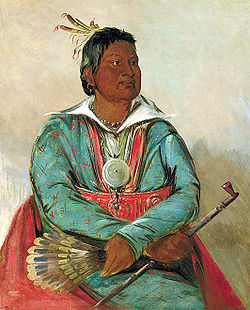List of Choctaw chiefs
 From Wikipedia - Reading time: 6 min
From Wikipedia - Reading time: 6 min
List of Choctaw chiefs is a record of the political leaders who served the Choctaws in Alabama, Louisiana, Mississippi, and Oklahoma.
Original three divisions
[edit]

The eastern Choctaw Nation, in what is now Mississippi and Alabama, was divided into three regions: Okla Hannali, Okla Falaya, and Okla Tannip.
Okla Hannali (Six Towns)
[edit]- Yowannee Mingo[1]
- Pushmataha
- Oklahoma or Tapenahomma (Nephew of Pushmataha)
- General Hummingbird
- Nitakechi
- Sam Garland
Okla Falaya
[edit]- Apukshunnubbee
- Robert Cole
- Greenwood Leflore
- Chief Red Turkey Feather of Okla Falaya Clan
Okla Tannip
[edit]- Homastubbee
- Mushulatubbee
- David Folsom
District Chiefs in the New Indian Territory
[edit]After removal, the Choctaws set up their government also divided up in three regions: Apukshunnubbee, Mushulatubbee, and Pushmataha. The regions were named after the three influential Choctaw leaders of the "old country."






Moshulatubbee District
[edit]- Mushulatubbee, 1834–1836
- Joseph Kincaid, 1836–1838
- John McKinney, 1838–1842
- Nathaniel Folsom, 1842–1846
- Peter Folsom, 1846–1850
- Cornelius McCurtain, 1850–1854
- David McCoy, 1854–1857
Apukshunnubbee District
[edit]- Thomas LeFlore, 1834-1838
- James Fletcher, 1838-1842
- Thomas LeFlore, 1842-1850
- George W. Harkins, 1850–1857
Pushmataha District
[edit]- Nitakechi, 1834-1838
- Pierre Juzan, 1838-1841
- Isaac Folsom, 1841-1846
- Nitakechi, Died
- Salas Fisher, 1846-1854
- George Folsom, 1850-1854
- Nicholas Cochnauer, 1854-1857
Unified leadership as governor
[edit]- Alfred Wade, 1857-1858
- Tandy Walker, 1858-1859
- Basil LeFlore, 1859-1860
Principal Chiefs
[edit]- George Hudson, 1860-1862
- Samuel Garland, 1862-1864
- Peter Pitchlynn, 1864-1866
- Allen Wright, 1866-1870
- William Bryant, 1870-1874
- Coleman Cole, 1874-1878
- Isaac Garvin, 1878-1880
- Jackson McCurtain, 1880-1884
- Edmund McCurtain, 1884-1886
- Thompson McKinney, 1886-1888
- Benjamin Franklin Smallwood, 1888-1890
- Wilson Jones, 1890-1894
- Jefferson Gardner, 1894-1896
- Green McCurtain, 1896-1900
- Gilbert Dukes, 1900-1902
- Green McCurtain, 1902-1906
The Choctaw Nation was temporarily discontinued in 1906 with the advent of Oklahoma statehood.
Choctaw Nation "token" government
[edit]Chiefs were appointed by the U.S. President after U. S. Congress stripped recognition of the Choctaw national government.
- Green McCurtain, 1906-1910, appointed by President Theodore Roosevelt
- Victor Locke, Jr., 1910-1918, appointed by President Howard Taft
- William F. Semple, 1918-1922, appointed by President Woodrow Wilson [2]
- William H. Harrison, 1922-1929, appointed by President Warren G. Harding
- Ben Dwight, 1930-1936, appointed by President Herbert Hoover
- William Durant, 1937-1948, appointed by President Franklin Delano Roosevelt
- Harry J. W. Belvin, 1948-1970, appointed by President Harry S. Truman
(Choctaw were allowed to elect their delegate in 1948 and 1954 which the president confirmed.)
Current tribes
[edit]Indian termination policy was a policy that the United States Congress legislated in 1953 to assimilate the Native American communities with mainstream America. In 1959, the Choctaw Termination Act was passed.[3] Unless repealed by the federal government, the Choctaw Nation of Oklahoma would effectively be terminated as a sovereign nation as of August 25, 1970.[3]
After a long struggle for recognition, the Mississippi Choctaw received recognition in 1918. The Mississippi Choctaw soon received lands, educational benefits, and a long overdue health care system.
In 1945, lands in Neshoba County, Mississippi and the surrounding counties were set aside as a federal Indian reservation. There are eight communities of reservation land: Bogue Chitto, Bogue Homa, Conehatta, Crystal Ridge, Pearl River, Red Water, Tucker, and Standing Pine. The Indian Reorganization Act of 1934 allowed the Mississippi Choctaws to become re-organized on April 20, 1945 as the Mississippi Band of Choctaw Indians.
Oklahoma Choctaws
[edit]Choctaw Nation of Oklahoma
[edit]- Harry J. W. Belvin, 1948, 1954, 1971–1975
- C. David Gardner, 1975–1978
- Hollis E. Roberts, 1978–1997
- Gregory E. Pyle, 1997–2014
- Gary Batton, 2014–Present
Mississippi Choctaws
[edit]
Pre-reorganization Era (Before 1945)
[edit]- Wesley Johnson (Wesley Wakatubee), 1913-c. 1914 (Chief)
- Ed Willis
- Pat Chitto
- Joe Chitto
Mississippi Band of Choctaw Indians (1945-Present)
[edit]- Emmette York (Chairman)
- Phillip Martin (Chairman)
- Calvin Isaac (Chief)
- Phillip Martin, 1978—2007 (Chief)
- Beasley Denson, 2007—2011 (Chief/Miko)
- Phyliss J. Anderson, 2011—2019[4] (Chief)
- Cyrus Ben, 2019—present (Chief)
Louisiana Choctaws
[edit]Jena Band of Choctaw Indians
[edit]- Christina M. Norris, present[5]
Notes
[edit]- ^ https://home.nps.gov/articles/choctaw-warriors-consider-alliances.htm [bare URL]
- ^ "Chiefs | Choctaw Nation".
- ^ a b "U.S. House of Representatives Resolution 108, 83rd Congress, 1953. (U.S. Statutes at Large, 67: B132.)". Digital History. Archived from the original on June 8, 2007. Retrieved May 2, 2008.
- ^ Meyers, Debbie Burt. "Anderson unseats Denson." Archived 2014-08-12 at the Wayback Machine The Neshoba Democrat. 7 Sept 2011 (retrieved 24 Sept 2011)
- ^ "Tribal Governments by Area: Southeast." Archived 2010-09-26 at the Wayback Machine National Congress of American Indians. (retrieved 7 Sept 2010)
 KSF
KSF